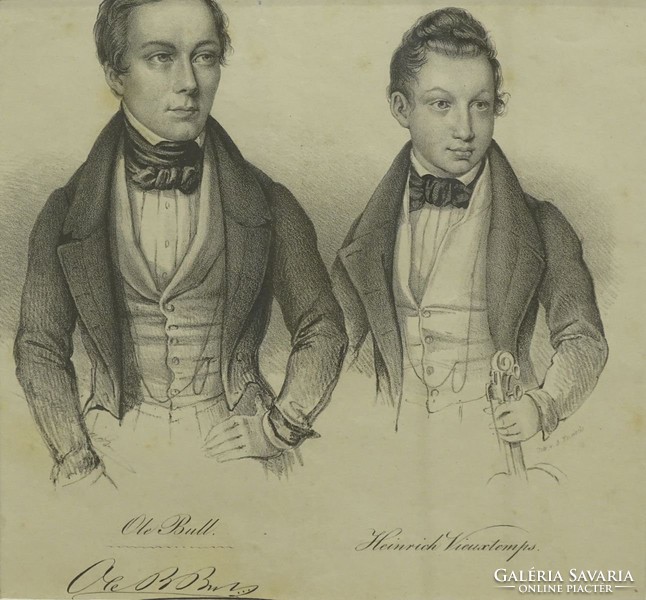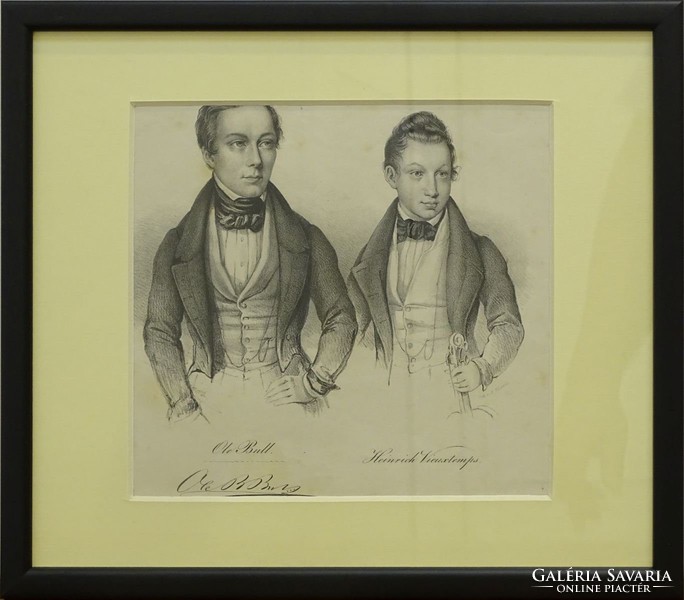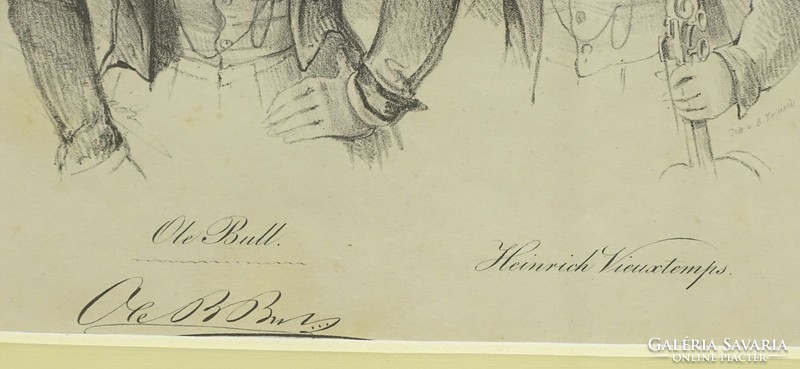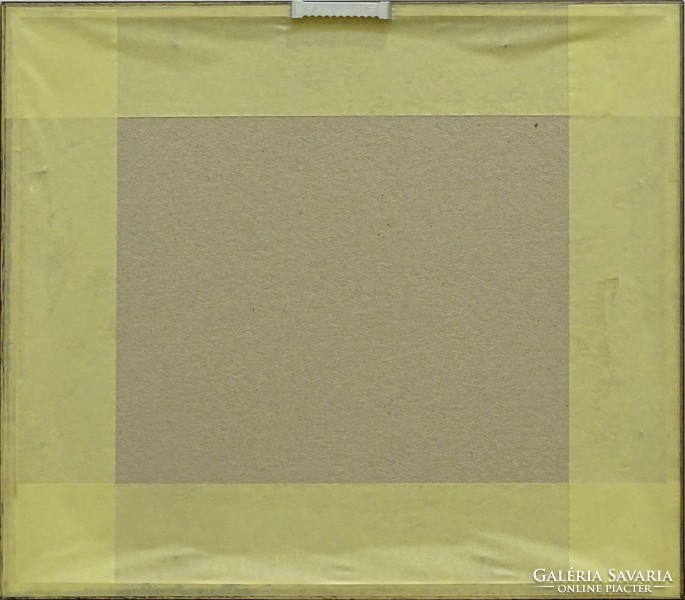0J876 Antik acélmetszet OLE BULL és H. VIEUXTEMPS
| Feltöltés ideje: 2023. november 24. |
| Termékkód: 1403372 |
| Megtekintések: 96 |
| Megfigyelők: 0 |
| Ajánlatok: 0 ajánlat |
regitargyaim (4821)
![]() BUDAPEST
BUDAPEST
Hitelesített felhasználó
Tudja meg, milyen lépésekkel tesszük biztonságosabbá és kényelmesebbé online piacterünk használatát. Részletek
| Téma: | portré |
| Eredetiség: | eredeti |
Szépen keretezett, paszpartuban és üveglap mögött található, hibátlan, ajándékozható állapotban lévő acélmetszet portré.
A képen látható személyek:
OLE BULL és HEINRICH VIEUXTEMPS
Szélesség: 31 cm
Magasság: 27 cm
Súly: 0.55 kg
Portré mérete: 17.5 x 19 cm
Ole Bull
From Wikipedia, the free encyclopedia
"Ole Bornemann Bull" redirects here. For the virtuoso's eponymous violin, see List of Stradivarius instruments § Violins. For the ophthalmologist, see Ole Bornemann Bull (physician).
Ole Bull
Background information
Birth name
Ole Bornemann Bull
Born
5 February 1810
Origin
Bergen, Norway
Died
17 August 1880 (aged 70)
Genres
Classical
Occupation(s)
Musician
Instruments
Violin
Ole Bornemann Bull (Norwegian pronunciation: [ˈu:lə ˈbʉl];[1] 5 February 1810 – 17 August 1880) was a Norwegian violinist and composer.[2][3]
Contents- 1Biography
- 1.1Background
- 2Career
- 2.1Ole Bull Colony
- 2.2Family life
- 2.3Later years
- 3Legacy
- 4References
- 5Further reading
- 6Media
- 7External links
BiographyBackground
Bull was born in Bergen, Norway. He was the eldest of ten children of Johan Storm Bull (1787–1838) and Anna Dorothea Borse Geelmuyden (1789–1875). His brother, Georg Andreas Bull became a noted Norwegian architect. He was also the uncle of Edvard Hagerup Bull, Norwegian judge and politician.
His father wished for him to become a minister, but he desired a musical career. At the age of four or five, he could play all of the songs he had heard his mother play on the violin. At age nine, he played first violin in the orchestra of Bergen's theatre and was a soloist with the Bergen Philharmonic Orchestra.[4] At eighteen, he was sent to the University of Christiania, but failed his examinations. He joined the Musical Lyceum, a musical society, and after its director Waldemar Thrane took ill, Bull became the director of Musical Lyceum and the Theater Orchestra in 1828.[5] He also became friends with Henrik Wergeland, who later wrote a biography of Bull.[5]
Henri Vieuxtemps
From Wikipedia, the free encyclopedia
Henri Vieuxtemps, Lithograph byJosef Kriehuber, 1842
Henri François Joseph Vieuxtemps (French: [ɑ̃ʁi fʁɑ̃swa ʒɔzɛf vjøtɑ̃] 17 February 1820 – 6 June 1881) was a Belgian composer and violinist. He occupies an important place in the history of the violin as a prominent exponent of the Franco-Belgian violin school during the mid-19th century. He is also known for playing upon what is now known as the Vieuxtemps Guarneri del Gesù, a violin of superior workmanship.
Contents- 1Biography
- 2Vieuxtemps del Gesù
- 3Major works
- 4References
- 5External links
Biography
Vieuxtemps was born in Verviers, Belgium (then part of the Netherlands), son of a weaver and amateur violinist and violin-maker. He received his first violin instruction from his father and a local teacher and gave his first public performance at the age of six, playing a concerto by Pierre Rode. Soon he was giving concerts in various surrounding cities, including Liège andBrussels where he met the violinist Charles Auguste de Bériot, with whom he began studies. In 1829, Bériot took him to Paris where he made a successful concert debut, again with a concerto by Rode, but he had to return the next year because of the July Revolution and Bériot's marriage to his mistress Maria Malibran and departure on concert tour. Back in Brussels, Vieuxtemps continued developing his violin technique on his own, his musicianship deepened by playing with the deeply musical mezzo-soprano Pauline Viardot, Malibran's sister. A tour ofGermany in 1833 brought friendship with Louis Spohr and with Robert Schumann, who compared the boy to Niccolò Paganini. During the following decade he visited various European cities, impressing with his virtuosity not only audiences but also famous musicians such as Hector Berlioz and Paganini himself, whom he encountered at his London debut in 1834.
But he had aspirations of becoming a composer as well and, having already taken lessons with the respected Simon Sechter in Vienna, spent the winter of 1835–1836 studying composition with Anton Reicha in Paris. His first violin concerto, later published as Concerto No. 2, dates from this time.
Vieuxtemps's Violin Concerto No. 1 was acclaimed when he played it in Saint Petersburg on his second visit in 1840 and in Paris the next year; Berlioz found it "a magnificent symphony for violin and orchestra". Based in Paris, Vieuxtemps continued to compose with great success and perform throughout Europe. With the pianist Sigismond Thalberg, he concertized in the United States. He was particularly admired in Russia where he resided permanently between 1846 and 1851 as a court musician of Tsar Nicholas I and soloist in the Imperial Theatre. He founded the violin school of the Saint Petersburg Conservatory and guided the formation of a "Russian school" of violinists. In 1871, he returned to his native country to accept a professorship at the Brussels Conservatory, where his most illustrious pupil was Eugène Ysaÿe. For other students, See: List of music students by teacher: T to Z#Henri Vieuxtemps.
A paralytic stroke disabled his right arm two years later and he moved to Paris again, his violin class being taken over by Henryk Wieniawski. Although he seemed to be gradually recovering from his stroke, another one in 1879 ended his career as a violinist for good. He spent his last years in a sanatorium in Mustapha Supérieur, Algeria, where his daughter and her husband had settled, and continued to compose, though frustrated by his inability to play or, far from the musical centres of Europe, even hear his music played by others.
The bulk of Vieuxtemps's compositions were for his own instrument, including seven concertos and a variety of short salon pieces, though towards the end of his life, when he had to give up the violin, he often turned to other instruments, writing two cello concertos, a viola sonata and three string quartets among other things. It is because of his seven violin concertos, however, that Vieuxtemps is generally known to audiences and musicians around the world. Through his own concertos and his advocacy of the concertos of Beethoven (he also played Beethoven's sonatas and string quartets) and Mendelssohn, he added a more classical dimension to the violin repertoire which had tended towards technically brilliant but often shallow variations and fantasies on popular operatic themes. Vieuxtemps never indulged in sheer virtuosity for its own sake, like some of his predecessors. Eugène Ysaÿequotes him as saying "Not runs for the sake of runs - sing, sing!" [1]
Forrás: www.wikipedia.org
Garanciális feltételek
| Garancia: örökös |
Fizetési opciók
| Banki előre utalás |
| Készpénz |
| Postai utánvétel |
| PayPal |
Szállítási opciók
| Szállítás innen: Magyarország Feldolgozási idő: 1-2 munkanap A feldolgozási idő megmutatja, hogy az eladónak a fizetéstől számítva mennyi időre van szüksége a tárgy becsomagolásához és feladásához. Ez alapján tájékozódhat a vevő, hogy a fizetést követően mikor várhatja a csomag feladását. | |
| Személyes átvétel | Budapest IX. |
| MPL - csomagautomata | 1650 HUF |
| MPL - házhozszállítás | 1800 HUF |
| PostaPont | 1650 HUF |




